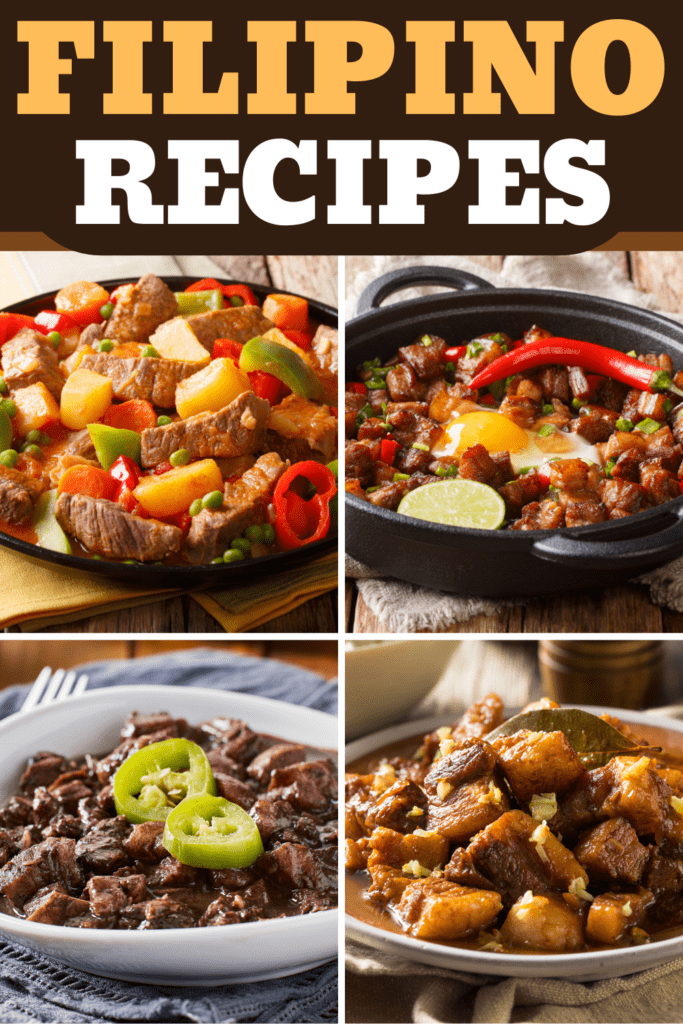Authentic Filipino Food Recipes to Try at Home
Exploring genuine Filipino food recipes offers a possibility to appreciate the detailed tastes and cultural value behind each recipe. Making use of fresh, neighborhood components is crucial, as is embracing communal eating-- a hallmark of Filipino culture.
Popular Filipino Dishes
Filipino cuisine boasts an abundant tapestry of tastes and traditions, with over a lots iconic meals that highlight the country's varied cultural impacts. One of one of the most well-known dishes is Adobo, a mouthwatering stew typically made with chicken or pork, marinated in vinegar, soy sauce, garlic, and seasonings. Its appetizing flavor profile makes it a staple in Filipino households.
An additional beloved dish is Sinigang, a sour soup usually made with tamarind, tomatoes, and various veggies. This recipe can include pork, shrimp, or fish, and its refreshing preference is ideal for warm climates. For those with a craving for sweets, Leche Flan-- a creamy caramel custard-- works as a prominent dessert, showcasing the Filipino penchant for abundant, sweet tastes.
Kare-Kare, a passionate oxtail stew with a thick peanut sauce, along with the iconic lumpia, or spring rolls, even more exemplify the selection located in Filipino food. Each meal not just provides unique tastes however additionally narrates of local ingredients and historic influences, making Filipino food a vivid representation of its culture and heritage.
Important Components for Filipino Cooking
The essence of Filipino food preparation hinges on its crucial components, which function as the foundation for the country's beloved meals. A selection of flavors and structures come with each other, showcasing the diverse social influences that shape Filipino cuisine.
Trick components consist of rice, the staple that accompanies almost every meal, symbolizing food and community. Soy sauce, vinegar, and fish sauce (patis) are critical for seasoning, conveying umami and depth to recipes. Fresh natural herbs like cilantro and basil add fragrant freshness, while garlic, onion, and ginger supply a durable taste base.
Healthy protein sources such as pork, chicken, and fish and shellfish are main to several recipes, often seasoned to boost preference. Vegetables like eggplant, bitter melon, and eco-friendly beans contribute essential nutrients and equilibrium - Filipino food recipes. Coconut milk is an additional considerable component, offering creaminess and a subtle sweetness to different stews and desserts
Lastly, calamansi, a citrus fruit, supplies a revitalizing flavor that raises recipes and beverages alike. Together, these components develop the vivid and rich tapestry of tastes that define Filipino food, making it both reassuring and distinct. Recognizing these basics is crucial for any person wanting to reproduce authentic Filipino recipes at home.
Step-by-Step Recipe Guide

Start by preparing your ingredients. For Adobo, cut the meat right into consistent items and season it in soy sauce, vinegar, garlic, and bay leaves for a minimum of half an hour. Next, warmth oil in a frying pan and sauté the garlic and onions up until great smelling, after that include the marinated meat, allowing it to brownish uniformly.
For Sinigang, begin by boiling water in a pot and adding your selection of meat. When tender, integrate tamarind paste or fresh tamarind for that signature sour taste. Adhere to with veggies like radish and kangkong, food preparation up until simply tender.

Tips for Genuine Taste
Usually, attaining authentic flavor in Filipino meals hinges on the mindful option and therapy of ingredients. Begin with fresh, top notch fruit and vegetables, as the vibrancy of vegetables and herbs significantly improves the meal's overall preference. his response Staples like garlic, onions, and ginger form the fragrant structure for numerous recipes; using them in appropriate percentages is critical.
Selecting the appropriate healthy protein is just as important. Traditional adobo typically uses poultry or pork, marinated to take in the sauce's full flavor. In addition, take into consideration sourcing in your area generated or regional components, as they can give credibility that store-bought choices lack.
Cooking techniques additionally play an important role. Slow-cooking approaches, such as braising or stewing, allow flavors to fuse perfectly, while frying can include a satisfying structure. Do not ignore flavoring; utilizing salt, fish sauce, or soy sauce at the appropriate moments can raise a dish substantially.
Serving and Delighting In Filipino Food
Culinary experiences are improved when Filipino food is served with focus to tradition and area. The practice of sharing meals is central to Filipino society, signifying unity and hospitality. When serving Filipino recipes, take into consideration making use of standard serveware, such as clay pots or bamboo baskets, which boost the credibility of the experience.
Usually, Filipino dishes are enjoyed family-style, with a variety of meals put at the center of the table. This communal technique motivates interaction and allows visitors to example different flavors. A well-curated spread could consist of staples like adobo, sinigang, and lumpia, complemented by rice, which is a fundamental part of every dish.
Accompanying the food with standard spices, such as soy sauce, vinegar, or chili paste, can elevate the eating experience, welcoming restaurants to tailor their plates to their choices. Additionally, integrating local like it beverages, like calamansi juice or tuba, can improve the overall flavor profile.
Final Thought
:max_bytes(150000):strip_icc()/Ginataang-Gulay-Filipino-Vegetable-Stew-FT-RECIPE1023-4e7dd044042f49549a2c3421a03faf60.jpg)